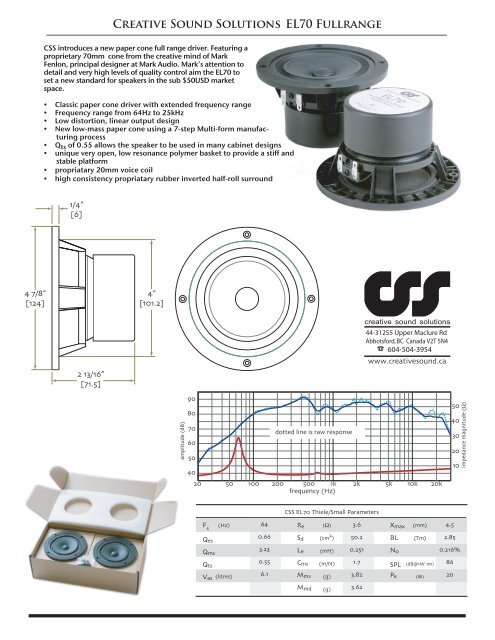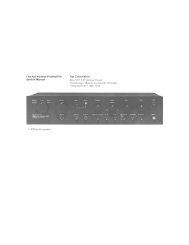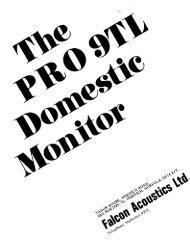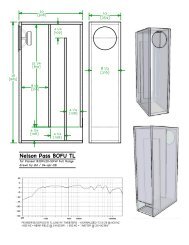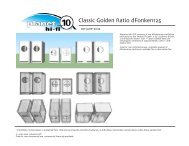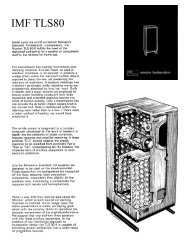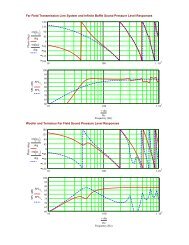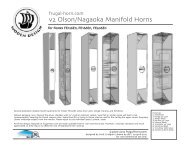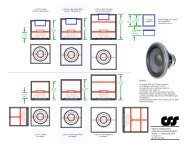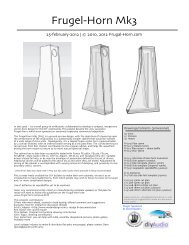CSS EL70 - SpectrumAudio
CSS EL70 - SpectrumAudio
CSS EL70 - SpectrumAudio
- TAGS
- spectrumaudio
Create successful ePaper yourself
Turn your PDF publications into a flip-book with our unique Google optimized e-Paper software.
Comments from the Designer of the <strong>EL70</strong>Hi,Bob has asked me to point out some features on the <strong>EL70</strong>. Much of the following info also applies to my otherdesigns.Please take a look at the picture as I've numbered the features.1/ Surround: there’s various grades of material available. Cheaper drivers will use single or dual mix butyl. The <strong>EL70</strong>uses a tri-mix Ei grade, a type mostly found on more expensive units. We test each cone/surround sub-assembly tobe within ± 3(Fo-Hz) of its design rating. This is very close tolerance for a lower cost driver.2/ Bonds: single bond glues cost less. On the <strong>EL70</strong>, an A/B mixed bond is used to get the solid connection neededto make the cap acoustically efficient.3/ Cones: there's a lot of talk about paper cones. The<strong>EL70</strong>’s cone paper is sourced from Japan, the source formost of the best papers. The material is important butalso must be accurately moulded. Our new Multiformprocess give us micro-control over the complete surface ofthe cone, making all production cones precise at the microlevel.4/ Frame: is a mixed polymer. It is rigid, strong and acts as aresonance damping component. I make no apologies tothose who love metal frames, many ring like a bell sendingstray resonance's into the cabinet. We could have cut costsby using an “off the shelf” frame, instead the <strong>EL70</strong> uses thesame Markaudio custom frame found on the CHR-70.5/ Connector: this humble part is custom sized. So manydrivers come with this component straight from the partsbin, not the case for the <strong>EL70</strong>. Most cheap drivers havethis part riveted to the frame. On the <strong>EL70</strong>, its glued andscrewed.6/ Coil to cone: the fit tolerance on many cheaper drivers isup to 0/+0.5mm. On the <strong>EL70</strong>, its 0/+0.1mm. We use lessglue because the fit is more accurate. Less glue means lessmass and less variation in the moving mass of the power-train.7/ Spiders: cheaper drivers (and many expensive units) useConex and similar grade materials. These grades of materialare mostly fine depending on the weave selection for agiven load. The factory standard tolerance is +/-0.15 on thespecified stiffness rating. Typically, a spider can vary by as much as 35% of the mean stiffness within a batch. Thiscan result in a wide range of variance in the resonance frequencies within a batch of drivers. This is not the casewith the <strong>EL70</strong>. Each spider is individually checked to a working tolerance of +/-0.1, much tighter than most otherdriver production.8 - Power-train layout: This section of a driver design is critical. I design the layout to make sure there is no spiderdamage during the soldering process. One small undetected nick in the spider will reduce the life of the driver andresults in an un-even distribution of the stiffness compliance. The flying leads are accurately positioned withenough room to remain clear of other driver parts while under LF loads.These are some of the features, there's much more but I'll leave them for another time.Some of you know my approach to building drivers. For those who are new to these drivers, I “engineer” theseunits in order to gain consistent high performance and reliable service life.Cheers,Mark.


